When the Avengers Ruled, Part 1: The Serpent Crown Saga by Steve Englehart & George Pérez
The Serpent Crown Saga by Steve Englehart & George Pérez
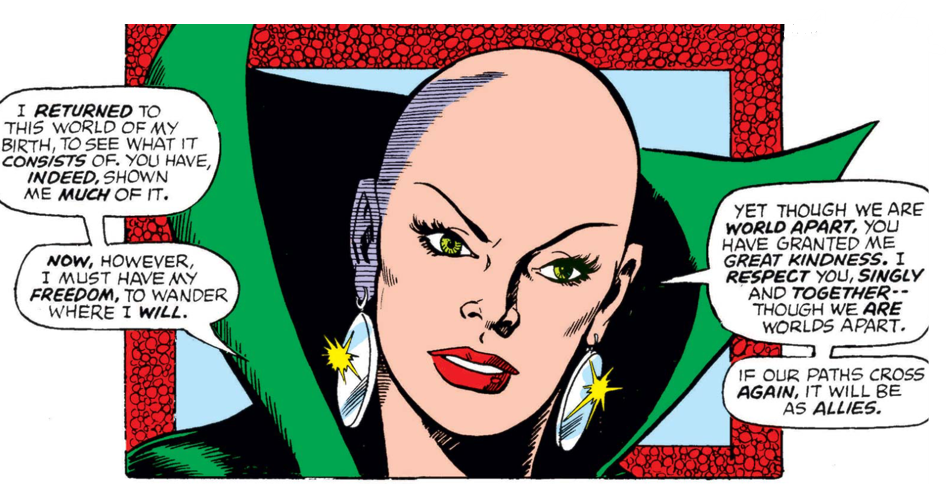
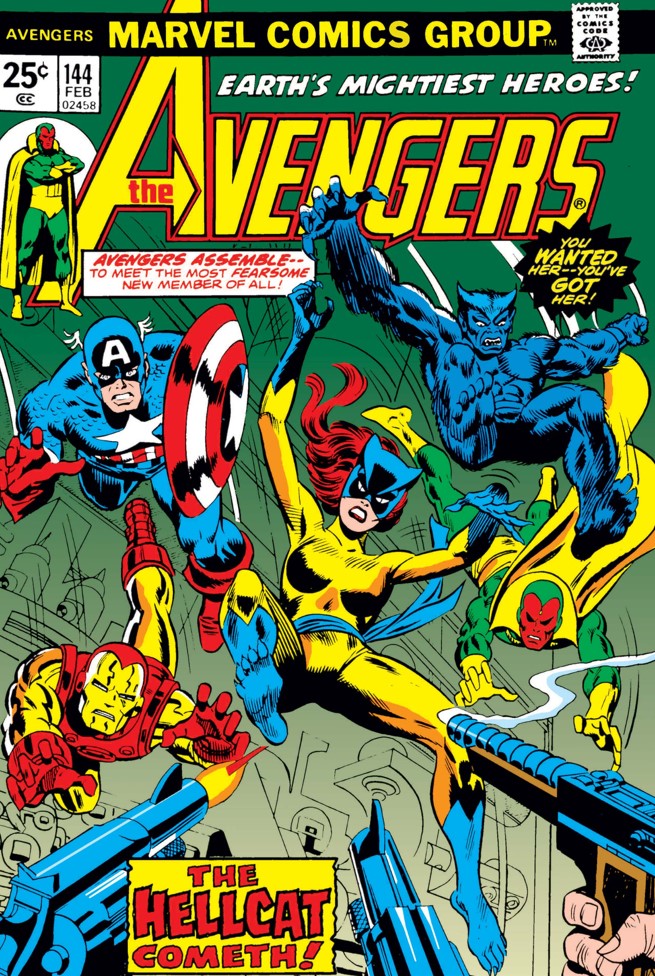
[Avengers #150 interior by Pérez; #144 cover by Gil Kane]
Hey, kids, it’s the kooky ’70s!
And we are deep in it with Steve Englehart’s Avengers finale, the culmination of his classic four-year run that began with such legendary tales as The Avengers/Defenders War and The Celestial Madonna Saga, wherein the modern reader will find much legend-making but much less sense-making. And that’s also true here at the end, but most of this longish “Serpent Crown” arc does make a good deal more sense than prior goings-on, in no small part because there are significantly fewer moving pieces—though there’s no shortage of variety throughout!
Critically as well is the arrival of the young George Pérez, who is far from revealing his mature style here but is nevertheless already doing much better work than the vast majority of what had gone before (excepting Neal Adams’ brief Avengers stint; Kirby’s own early run on the title was not the focus of the King’s energies, which hadn’t yet reached their peak in any case, so Pérez’s beginning here with “The Serpent Crown Saga” may be more visually memorable for many readers).
Our primary focus, though, will be on characters, ones you might not typically associate with the Avengers—especially if you’re not familiar with the classics! We will touch on the best plot point of the Crown part of “The Serpent Crown Saga”—the Crown’s diabolical nature being initially the most fascinating innovation here—but most of the story itself is negligible. Still, the Roxxon Corporation, a recent Englehart creation, does see further development here, so that’s something, too, especially insofar as it was Englehart who introduced into the still young Marvel universe the notion of a corrupt energy corporation with dirty fingers in lots of pies, not just politics and the military-industrial complex but, as seen here, in cosmic horror, too.
And obviously, the header images highlight two of the offbeat personalities we’ll delve into, but before we even get to Patsy Walker (her introduction into mainstream continuity here just being more Englehart whimsy, whatever its greater impact later on)—we’ll need to take a look at Englehart’s first Marvel assignment, chronicling the post-X-Men misadventures of the once-loveable, now loathsome Beast. (Really, though, his loveableness was pretty short-lived, all due to Englehart and David Michelinie, falling off quickly thereafter.)
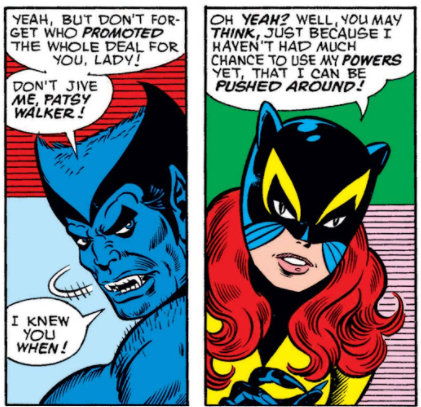
[Avengers #148]
I guess we must also acknowledge the Squadron Supreme, who make a supremely dull showing here—though that was their original raison d’être. After all, they were meant to be stooges standing in for the JLA of the Silver Age, godlike or lordly heroes who saw the world in black-and-white and were hardly relatable as Spidey or even Cap were. (Yet it was Englehart’s recent Captain America run that had really humanized Steve Rogers for the first time, at least in terms of real depth of character, albeit with great heaping doses of the familiar Stan Lee-style melodrama, just with much greater range and variety.)
Much more interesting for future stories is Moondragon’s outsized characterization—a joy to me but apparently not to the Avengers nor, presumably, most male readers of the day.
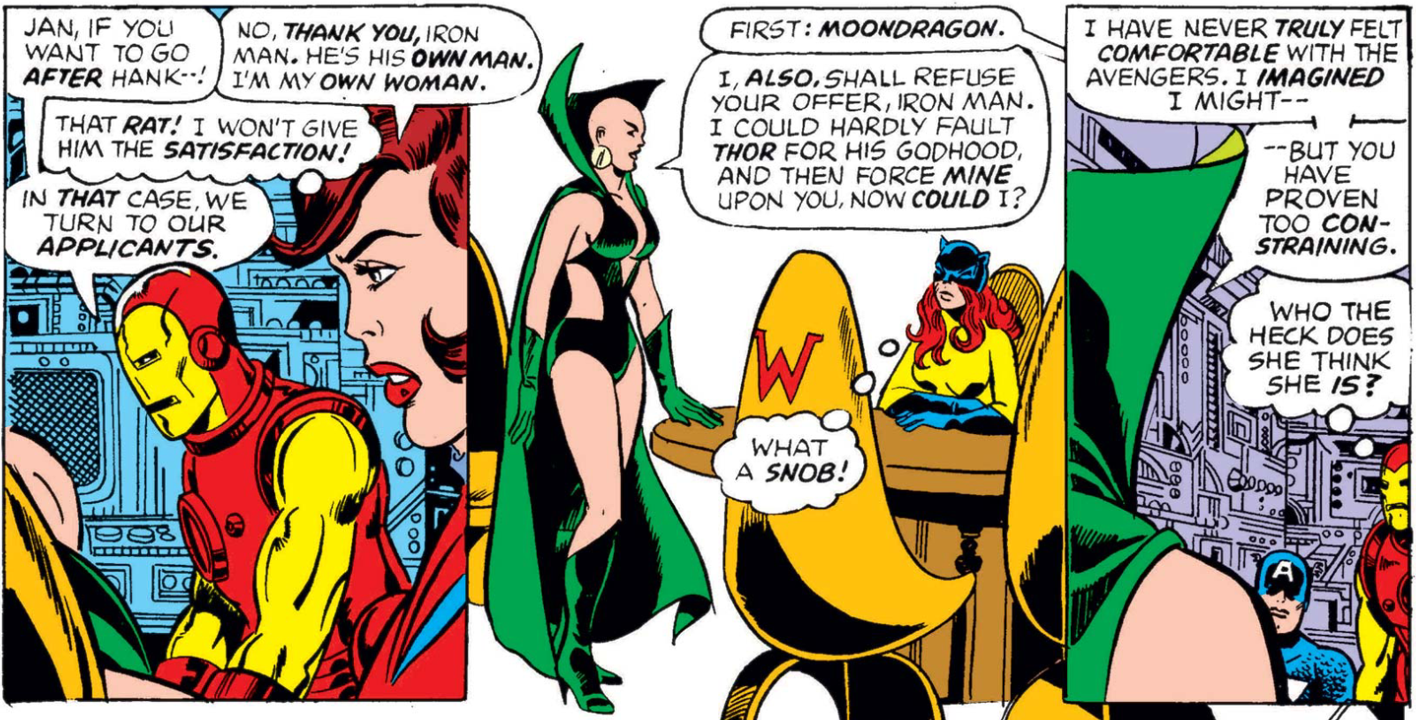
[#150 again]
However, Englehart has always been a fan of strong-willed women, which is clear from the opening pages of his Avengers run (started concurrently with his Captain America and Defenders runs, the latter of which featured the original Valkyrie), a notable departure from the young writer’s otherwise faithful emulation of Stan the Man. In context of what had come before, he really was delving into new territory, but nevertheless, his ability to write such powerful superheroines would soon be overshadowed by Claremont.
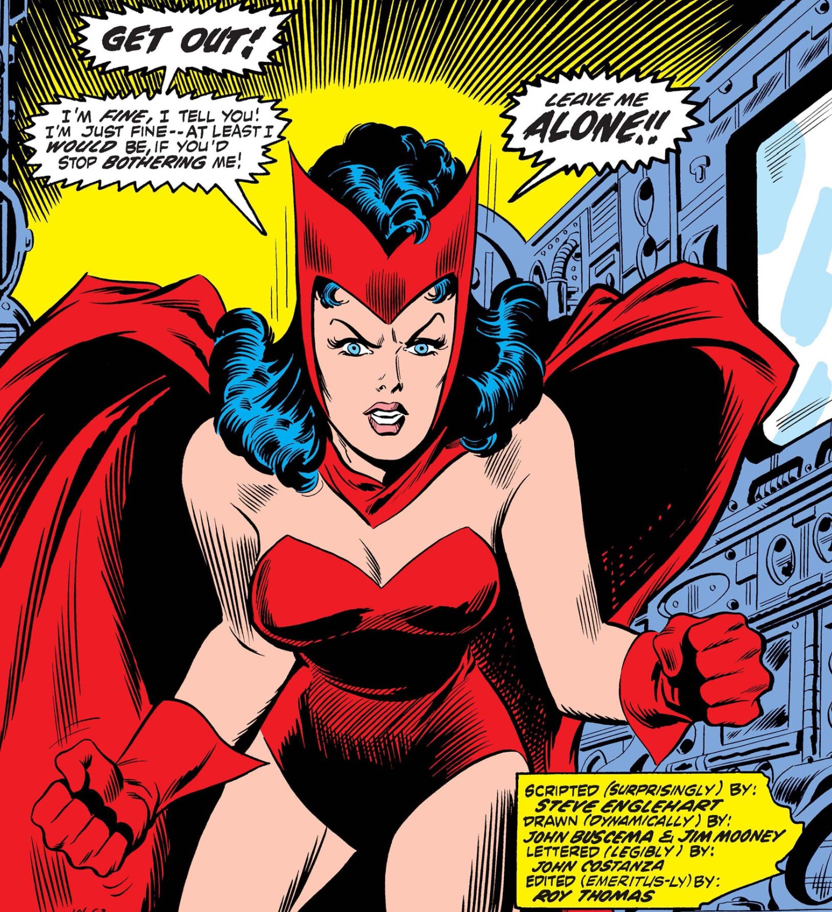
[Avengers #105, 1972]
It’s understandably easy for us today to miss the distinction Englehart brought to writing women leads because Claremont, beginning at the very end of Englehart’s initial stint at Marvel, would set the bar so high in this male-dominated medium full of misogyny. Certainly, Avengers suffered for this loss until Stern’s run, but even then, Stern doesn’t look particularly exceptional against Claremont’s example, which was followed by strong work from Louise Simonson and Ann Nocenti. (And compared to Jim Shooter, even John Byrne comes off as positively enlightened.)
(To be sure, though, Englehart’s work of the 1970s is a very far cry from anything like the representation modern readers expect today and which women have always deserved in this most skewed artform.)
Oddly enough, though, among Englehart’s superheroines, Moondragon, who was not a creation of his own, is his most enduring because there’s so much compelling ambivalence to her portrayal. No doubt, he was inspired by how Starlin had developed her in his recent “Thanos War,” of which Englehart wrote a tie-in (Avengers #125) and scripted the last chapter (Starlin’s Captain Marvel #33). So, having avenged her parents (the first modern humans killed by Thanos), this natural-born telepath (capable of rivaling Charles Xavier and Emma Frost) and orphan raised among the Titanian Eternals (earning a genius-level science education and martial arts training from her immortal guardians*) entered Avengers lore as an early candidate for “Celestial Madonna.”
(*Moondragon, the daughter of the man who was resurrected as the Titanian-engineered living weapon known as Drax the Destroyer, has herself felled in single combat two of Earth’s most formidable fighters: Psylocke and Captain America—in, respectively, Infinity War #4 and Warlock and the Infinity Watch #27.)
Now, let’s dive into the deep end of Englehart’s helter-skelter run, with:
The Serpent Crown Saga
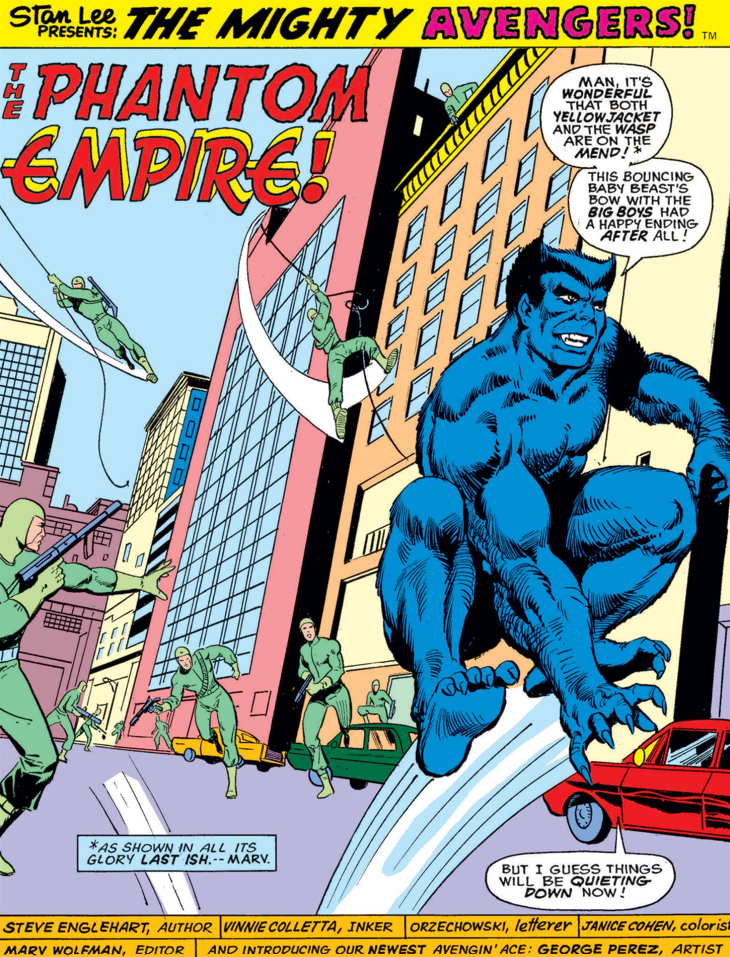
[Hot off his “Secret Empire” arc in Captain America, maybe Englehart wanted to signal he would now be uncovering a conspiracy infesting not just the Nixon White House but spanning parallel Earths, by way of the cosmic horror of a reptile-brained netherworld; thus, Chapter 1: “Phantom Empire”!]
What joy! The furry blue bouncin’ Beast is here! Avengers #141 arrived as Claremont was just two issues into his legendary X-Men run, when it was far from clear something truly special was afoot. (Warpath had just died in battle against Count Nefaria.) Thus, my chosen start for the halcyon years for the Avengers title coincides nicely with the Claremont era over in the X franchise. Yet while the Avengers’ quality would overall be much less consistent, these titles were really indicative of a big push in creative dynamism and sustained quality storytelling that lasted from the peak Bronze Age (mid-1970s) to the early Modern Age (not to be confused with the European city-states’ Renaissance  ). But here in 1975, the Avengers appeared to have a much stronger footing for future story potential, though equally the heft and momentum of its own accumulated continuity would prove its Achilles heel when stacked against the clean slate presented by Len Wein and Dave Cockrum in Giant-Size X-Men #1 (at the request of EIC Roy Thomas!).
). But here in 1975, the Avengers appeared to have a much stronger footing for future story potential, though equally the heft and momentum of its own accumulated continuity would prove its Achilles heel when stacked against the clean slate presented by Len Wein and Dave Cockrum in Giant-Size X-Men #1 (at the request of EIC Roy Thomas!).
This arc is also where the furry Beast’s bounding and boisterous personality is established, returning him somewhat to his early days but with more pizzazz and less self-centered insecurity (early X-Men)—though the insecurities are still in the wings, to be sure! (We’ll return to Englehart’s recent work on the character following his “secondary mutation” in Amazing Adventures volume 2 #11, but even there, Hank McCoy was stuck in quite the gothic-tinged melodrama, a fugitive dealing with the fallout of losing a cush R&D job and his prior identity to his bestial transformation.)
In fact, just Steve Englehart’s career at Marvel had a profound shaping influence. More original, energetic, and lighter on his feet than Roy Thomas, who was the main bridge between the Silver and Bronze Ages, Englehart had an enduring impact on Marvel’s Bronze Age that was perhaps second only to Roy’s. Maybe Jim Starlin could rate higher here, but his innovation was primarily in developing Marvel Cosmic before that was really a thing, and his broader influence wouldn’t become so clear until the Modern Era, with Infinity Gauntlet and all that followed.
However, given the helter-skelter nature of 1970s Marvel, with really not enough writers for so many titles, more new starts every year (most of them not getting very far), when you come across a proto-auteur like Englehart (or the less prolific Starlin), it can be tricky keeping track of their overall narrative interests and ongoing plot threads when they’re carried across multiple books with no obvious rhyme or reason—at least from the outside. From inside Marvel’s offices, it all made a kind of ad hoc sense as folks were picking up the slack whenever and wherever turnover occurred for whatever reason.
So, it must be said that while I think all the material here is perfectly enjoyable and entertaining on its own, your full appreciation of the core Serpent Crown story would require checking out the back half of Englehart’s legendary Captain America run, issues #169-186—most especially #180-182 (for Serpent stuff: the Serpent Squad and the Serpent Crown; and the Roxxon Corporations’s debut!). This era of Cap also introduces the Nomad concept and, wildest of all, President Tricky Dick Nixon as the Secret Empire’s “#1” killing himself rather than being caught and tried.
In this Avengers arc, The Serpent Crown Saga, it’s revealed that the Squadron’s home reality, Earth-712, didn’t have Cap around to root out the mythically reptilian evil infesting DC ( ), so their president, Norman Rockefeller (transpose his initials and who do ya get?!), is able to continue the corruption, combining the worst aspects of the Secret Empire’s Tricky Dick and the malign fixation of the Crown. Other elements Englehart is continuing from his previous Marvel work include the Beast, Patsy Walker, and the Brand Corporation, all from Amazing Adventures, which we’ll return to in the last section.
), so their president, Norman Rockefeller (transpose his initials and who do ya get?!), is able to continue the corruption, combining the worst aspects of the Secret Empire’s Tricky Dick and the malign fixation of the Crown. Other elements Englehart is continuing from his previous Marvel work include the Beast, Patsy Walker, and the Brand Corporation, all from Amazing Adventures, which we’ll return to in the last section.
In “The Serpent Crown,” Brand becomes the R&D arm of Roxxon, continuing Englehart’s framing of burgeoning corporate America as rife with not just the corrupting influence of cosmic horrors but also scientific hubris.
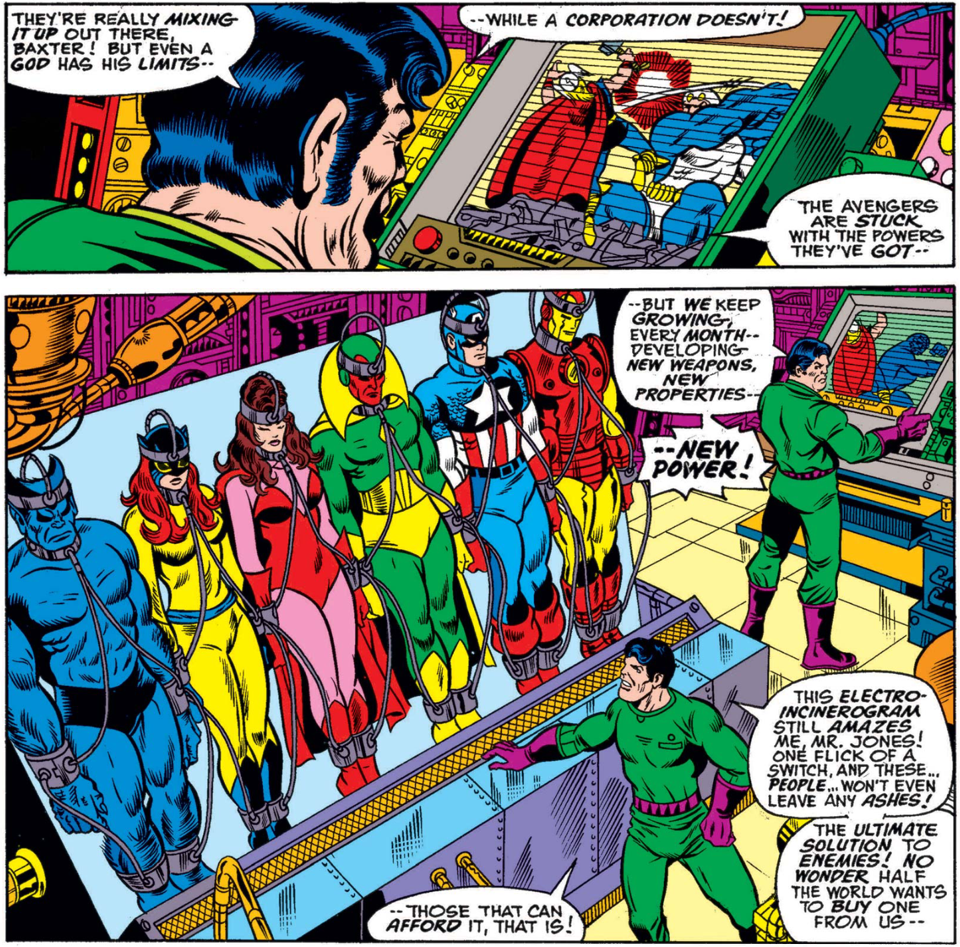
[#149]
Now, we’re about to discuss seven issues of Avengers, all (basically) of a piece, with a bizarre two-issue gap for issues #145-146. Strange—until you know that the young George Pérez was giving his all on his first run and found himself missing a couple of deadlines. So, editor Marv Wolfman brought in all different creators for something totally irrelevant to the ongoing narrative here. Don’t worry about it!
And while you’ll find Avengers #141-144, 147-149 collected as The Serpent Crown Saga, the material that explicitly pertains to the Serpent Crown is found only in the last three fascinating issues, where there’s a lot going on, especially compared to the preceding material, where our attention was also taken up with unrelated Kang business. By saga’s end, however, Roxxon’s odd dealings with the Squadron Supreme make much more sense as a (not-so-subtle) foothold by the imperial US president of the Squadron’s home reality that would secure the inter-universal invasion of “a single serpentine nether-mind” spanning the multiverse—since the Earth-616 Crown had been lost (Captain America #181), and the Elder God Set’s* psychic venom manifests only through each reality’s ancient Lemurian Crown—when set atop the head of someone who occupies a position of power and is (thus) easily corruptible. In this case, we have the zombified brains of the presidents of Roxxon and an alt-earth United States!
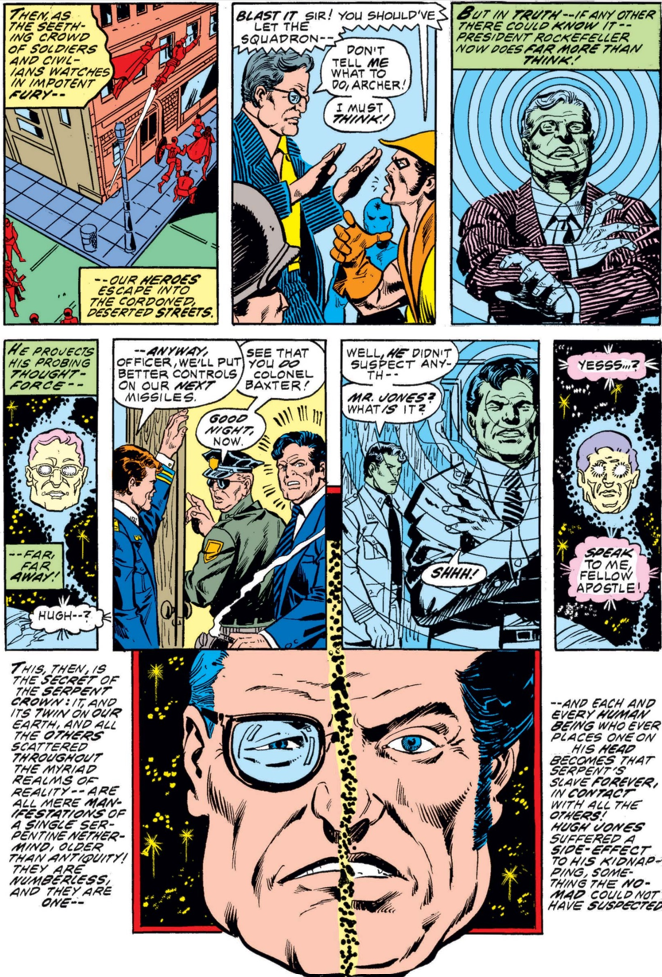
*
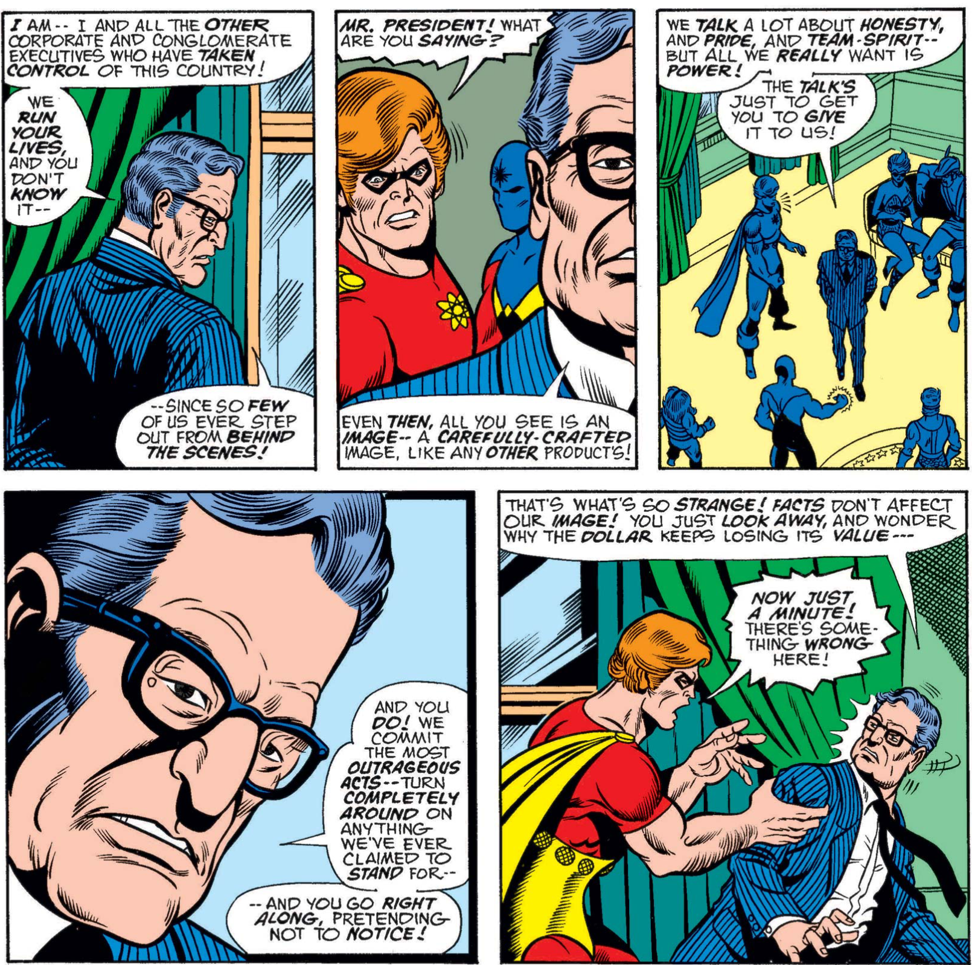
[#147, #148]
*Despite this “nether-mind’s” multiversal machinations, the explicit conceptualization of the multiverse does not exist at Marvel until Alan Moore and Alan Davis’ 1982-1984 Captain Britain adventures. Moreover, Set is never mentioned by name here in The Serpent Crown Saga, and this Elder God of Earth is never explicitly conceptualized or categorized as a multiversal entity or multiversal constant. But hey, developing a set-in-stone cosmogony wasn’t in anyone’s interest in the 1970s! Still, I have to say the notion of a Knull-like Set spanning the multiverse from its beginning is much more interesting to me than Knull himself ever was. Instead of the obviousness of being draped in symbiote goo, the Crown’s malign influence spreads merely by wearing it one time, and its psychic infection is maintained thereafter, allowing those corrupted to psychically contact one another across parallel realities. (The only Crown wearer ever exempted from this fate is Aunt Petunia’s ever-lovin’ blue-eyed nephew, the Thing—of course! This is in Mark Gruenwald’s excellent 1980 follow-up, which works as the third book of the unofficial Crown trilogy.)
I think the way Englehart conceptualizes the Crown and its schemes is really cool, and it’s all in the last part of the Avengers’ Serpent Crown Saga storyline/collection. In a moment, we’ll come back to the rest of what’s interesting here: Patsy Walker (and to a much lesser extent, the Squadron). But first, a bit of unfinished business—
“Right Between the Eons”  Where Gods Dare Barge in: Timeslip to Tombstone City, Arizona
Where Gods Dare Barge in: Timeslip to Tombstone City, Arizona
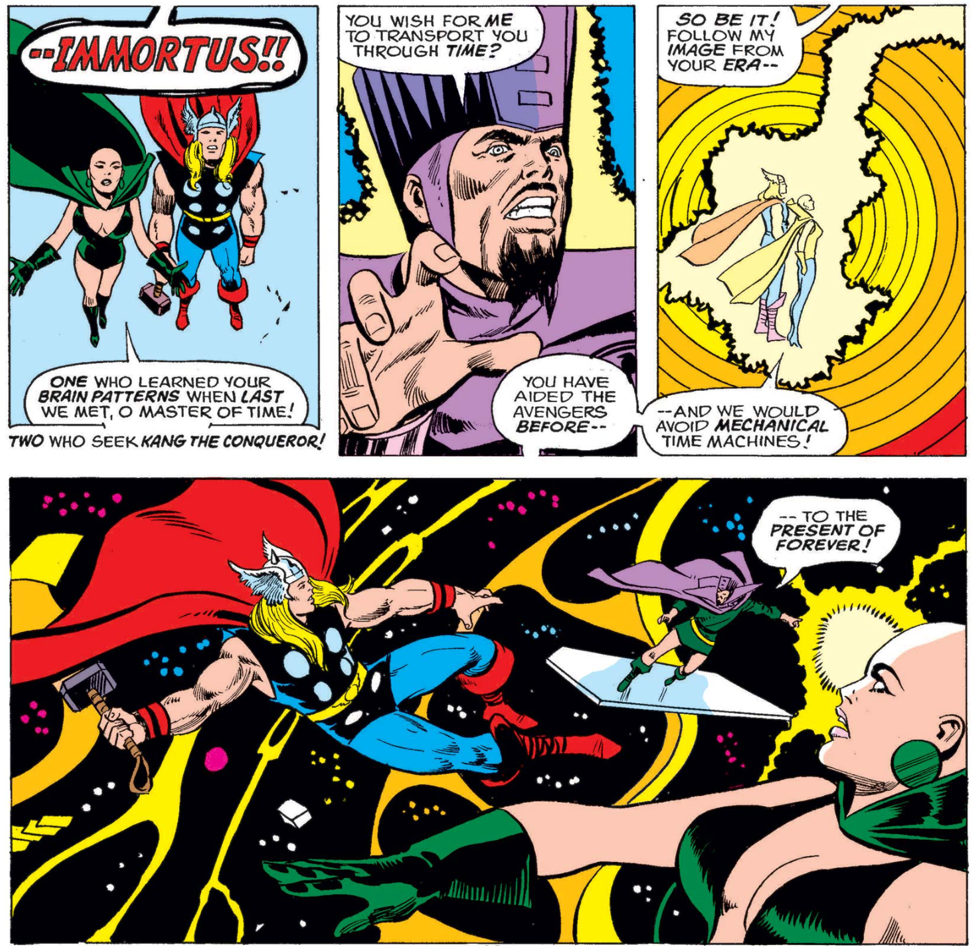
[#141]
The first three issues, particularly the second two, are preoccupied with Thor and Moondragon traveling back in time to 1873, with the help of Immortus*, in order to rescue a time-stranded Hawkeye and defeat Kang, who had recently gotten the brilliant idea of conquering the late-nineteenth century in order to thus conquer the twentieth and thereby prevent the existence of American superheroes altogether. Of course, somehow it made perfect sense to headquarter himself in Tombstone, Arizona rather than, say, London or New York City, especially a decade or so later—you know, actual centers of world power and influence!
Well, of course, it made sense, silly—because then writer Steve Englehart could have surprise appearances from his Golden Age favorites, long forgotten even by 1976: Two-Gun Kid, Rawhide Kid, Kid Colt, and Night Rider! Oh, and Ringo Kid! The Fantastic Kids! (Okay, sorry, I made up that last one.)
*It seems like Moondragon’s invocation of Immortus is just meant to show us her godlike powers—instead of having the pair rely on Doom’s time-travel machine (as Hawkeye had) or Thor himself. In this period, Thor’s powers did indeed include time travel, but I think that was done away with after The Korvac Saga.
Despite this silliness, Thor’s defeat of Kang is a spectacularly psychedelic freakout, largely thanks to Pérez’s unique depiction of Kang’s subatomic temporal shredding, or however Immortus hand-waves it. (Nowadays, post-HOX/POX, he would’ve explained how his younger self had sundered his own kirbons!)
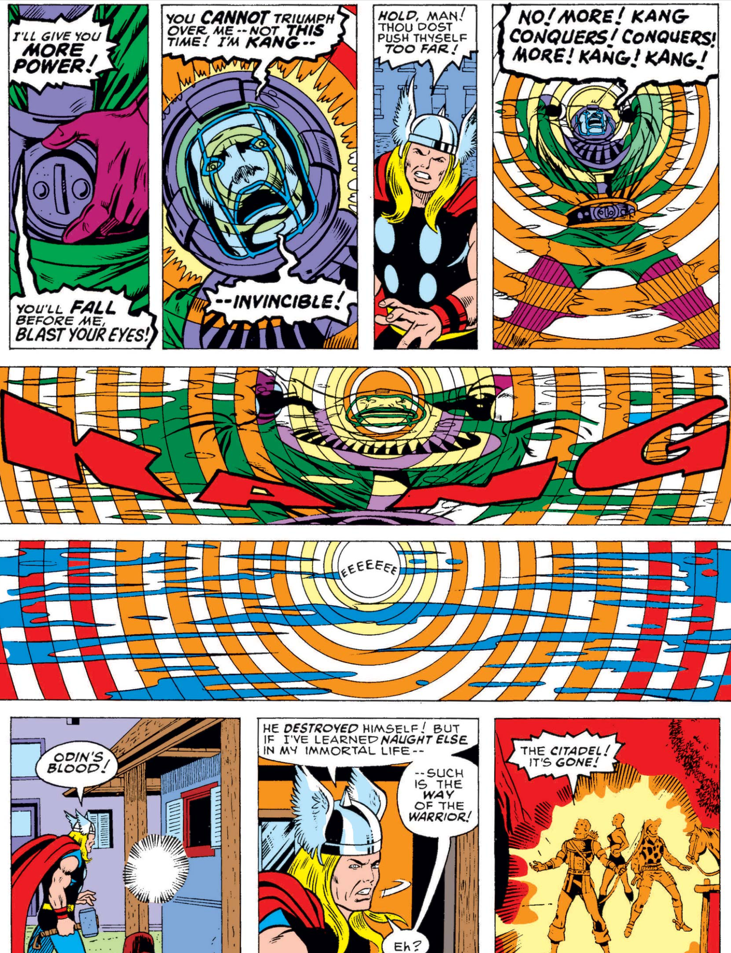
[#143]
(Equally silly, the blonde-haired, blue-eyed Hawkeye, unmasked and shirtless here, is somehow mistaken for an “Injun-man,” presumably because he wields a bow and arrow.)
Aside from being an excuse to bring Two-Gun Kid into the present, as Hawkeye’s sidekick or companion or something, this narrative thread has little effect beyond temporarily killing off Kang—for almost ten years, until his return in Jim Shooter’s Secret Wars, where he’s offed again a mere four issues in! While Englehart’s Kang of the Wild West vignette is a strange epilogue to his Celestial Madonna bizarrerie, it simply inaugurates the minor puzzle of Kang’s apparent immortality, eventually more or less solved by Roger Stern and Walter Simonson’s development of the Council of Kangs (which we’ll get to next year  ).
).
Despite the fact that Kang had already been around for over a decade at this point, the Kang mythology that we think of now as either fascinating or migraine-inducing wouldn’t settle into its baroque knottedness until the Council of Kangs and then throughout the ’90s.
But here, with his younger self dead, Immortus himself fades from existence (supposedly). Oddly enough, though, he pops up again far sooner than Kang! In Thor #281-282 (cowritten by Mark Gruenwald, 1979), Immortus’ servant Space Phantom (still just singular) tells the baffled Thunder God, “I did not know that my master enjoyed deception as much as I.” Of course, readers would have to wait many years for anything approaching an attempt at explanation—beginning with the Council of Kangs.
Beyond Kang’s violent disintegration here, the other classic moment is from Moondragon gazing up at Immortus, to her one of the gods of reality (of which she of course considers herself a member!), and tearing up at the oddly anticlimactic fadeout of this mini-Gotterdammerung.
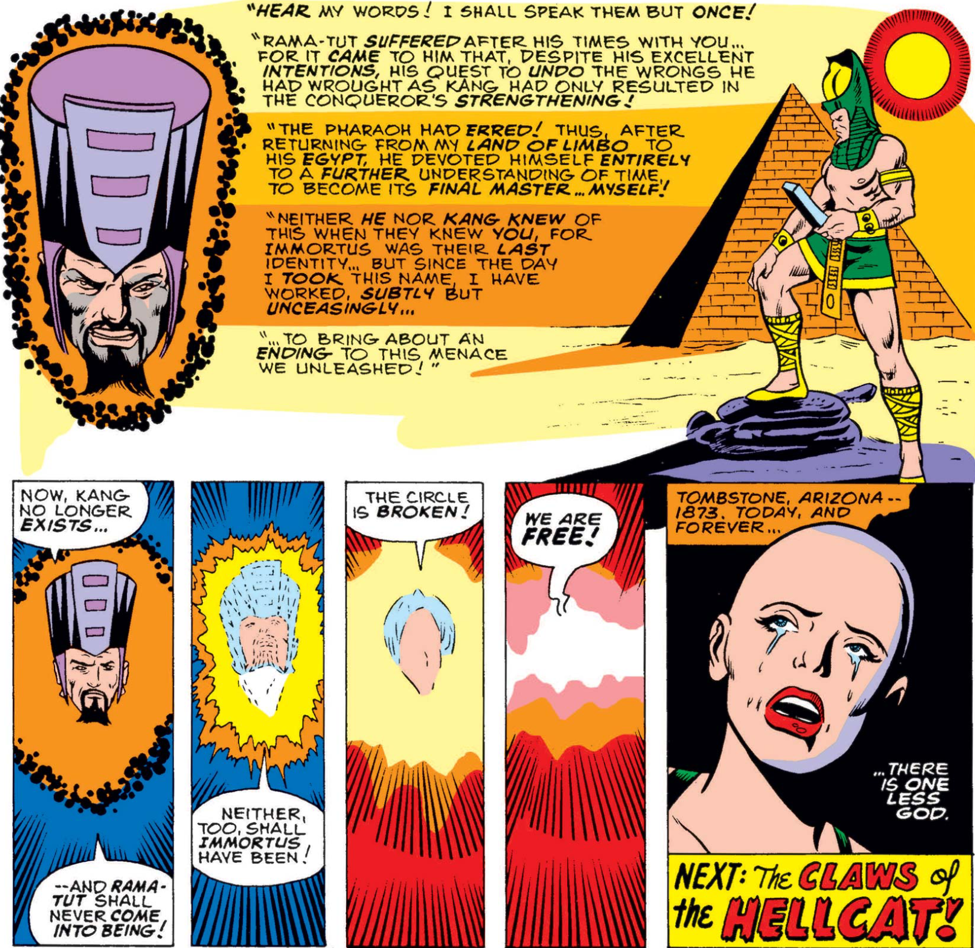
We also see Thor edge toward berserker rage, goaded by the comical D-list villain Orka amped up by Roxxon/Brand’s super-science upgrades (which are not explained in the least). It’s a minor revelation here in these early days when Thor’s character was still frozen at stoic beefcake. So, Moondragon is responsible for unlocking a greater depth of characterization with the Thunder God, who realizes that he’s been restraining himself on Midgard, for fear of damaging fragile mortals, including his teammates!
Unfortunately, like another Englehart heroine, Moondragon would soon be relegated to the deep end of the Defenders, primarily the series-ending Peter Gillis run. However, Starlin always maintained his interest in her, having her play an important role in his upcoming Warlock/Magus epic, and she’s more prominent in “The Korvac Saga,” which we’ll cover next time.
Englehart as Counterculture Conspiracy Theorist—and how Patsy Walker stepped into Earth-616
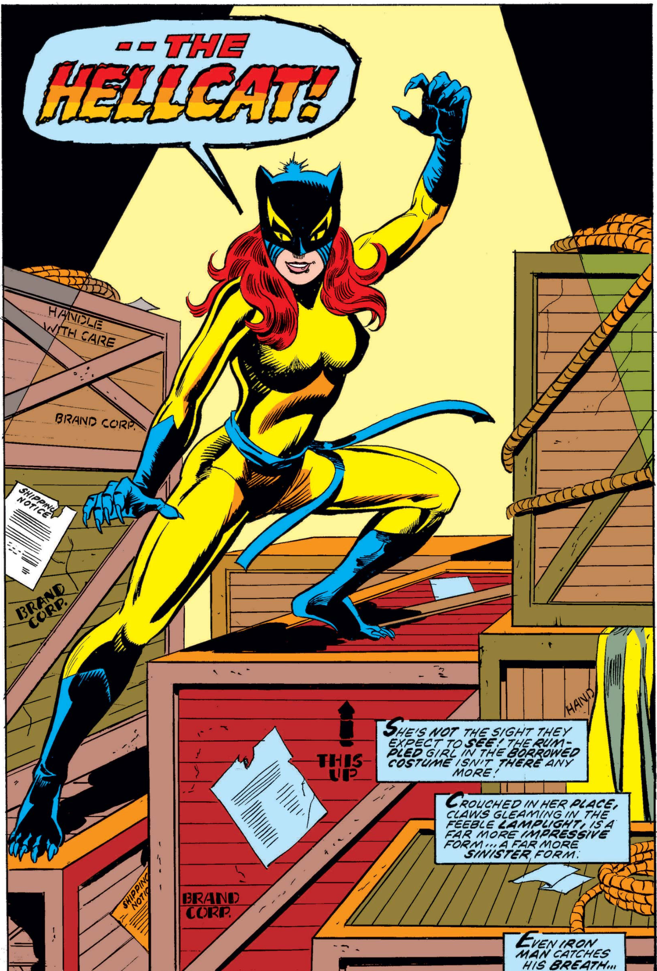
[#144]
To fully understand how Patsy Walker steps so readily into the big leagues here, well, we shouldn’t let Beast get in the way of her just having a well-deserved prominent place in the Marvel Universe. After all, she had starred from 1945 to 1967 in her own very popular self-titled teen-humor series (turning to young romance by 1964), the only case of a lead character carrying through Marvel’s iterations as Timely and Atlas Comics and straight into Silver Age Marvel. Longtime love interest Buzz Baxter also appeared throughout. (Interestingly, future Mad magazine mainstay Al Jaffee helmed Patsy Walker’s early days.) But this title and related spinoffs have never seriously been considered part of Earth-616 continuity.
Yet, randomly enough, it was in the pages of Beast’s (blessedly) brief solo jaunt, Amazing Adventures volume 2 #11-17, that Patsy and Buzz were brought into mainstream continuity, apparently just so that Englehart could do some light wink-wink satire, placing this all-American couple in the Bronze Age world of political seediness, social decay and moral ambiguity. Although, yes, as Jan mentions in Avengers #141, she did enjoy a brief cameo in Fantastic Four Annual #3 in 1965, the famous Sue and Reed wedding issue from Stan and Jack.
Starting with Amazing Adventures #13, Patsy and Buzz are married, and the latter is now a colonel working as a consultant for military contractor the Brand Corporation, a new minor player starting with issue #11 (written by Gerry Conway who left the title after penning its most relevant chapter), which Englehart reveals to be just a Roxxon R&D subsidiary (that Roxxon would close in the early 1980s).
In 1972’s Amazing Adventures #11, Gerry Conway introduced the furry Beast, after Hank McCoy, with a painfully self-evasive degree of conflicted willfulness, experiments on himself with horrific results. This description isn’t an antimutant sentiment; it is simply perfectly in line with the loosened restrictions of the 1970s, when Marvel went all in on introducing horror genre elements after more than a decade of Comics Code-endorsed Satanic Panic (which would never really go away).
Englehart’s further development of this character reinvention cements the melodramatic horror elements initially baked into this timely 1970s renovation. Of course, the goofy comedy both writers were known for ultimately wins through during his next long phase, as an Avenger—though when the focus narrows down to just him, he’s depicted as a brooder and often histrionic, of course! So, it’s Englehart who first teased out of the Beast’s verbose, hyperrational mind the deeper atavistic urges that, congenitally “innate” or conjured from paranoia, seem to drive so much of his faux-naïve characterization. Still, his initial furry portrayal played to the era’s penchant crazed, gothic horror.
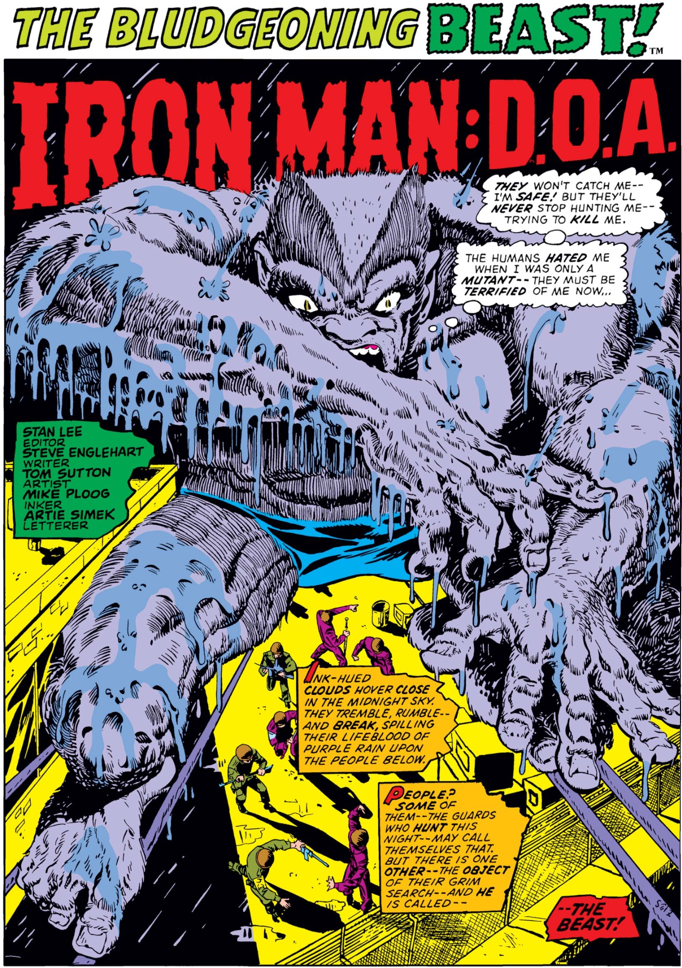
[Amazing Adventures #12]
During Englehart’s six-issue run, Patsy’s “American dream” marriage to Buzz falls apart and she takes in Hank, who is now unrecognizable as the transformed Beast and a fugitive from corrupt justice and corporate vengeance—perennial Englehart themes.
Patsy immediately gains metahuman powers as soon as she dons the Hellcat costume, which—as seen in Linda Fite and Marie Severin’s short-lived Cat series*—had originally been meant for Greer Nelson, who required a lot of training while wearing the suit. Now, in Avengers, it’s as if it has magical properties!
(*The Marvel fandom site calls this four-issue limited series and the likewise brief-lived Night Nurse and Shanna the She-Devil the result of “Marvel’s brief flirtation with women’s liberation” in late 1972. Afterward, less than two years later, Greer reappears in a bikini and transformed into Tigra! Courtesy of Tony Isabella and Don Perlin, perhaps at Roy Thomas’ request, in Giant-Size Creatures #1. Linda Fite, Jean Thomas (wife of Roy Thomas at the time) and Carole Seuling had their moment with these three titles, and that was pretty much it for their writing careers at Marvel.)
Unfortunately, despite becoming an honorary member, Patsy disappears from the Avengers once Shooter takes over—no surprise there (and after his egregious handling of Carol Danvers, his interest soon turned to the more easygoing, bikinied Tigra). But while she becomes core to the Defenders roster, with issue #44, staying confined to that one title for the better part of a decade, whatever its beloved cult status, did not help her continued relevance to the wider MU. Her big moment here arrives at the end of J.M. DeMatteis’ run, where she’s married off to Daimon Hellstrom (Son of Satan), after which both characters are relegated to the deep background, until the bizarre, short-lived Hellstorm series of the early ’90s—where she is damned to Mephisto’s Hell. Then, she is truly gone for many years, until Fabian Nicieza and Kurt Busiek’s resurrection/reintroduction of her in a pair of excellent 2000 annuals, Thunderbolts and Avengers.
Squandered Squadron
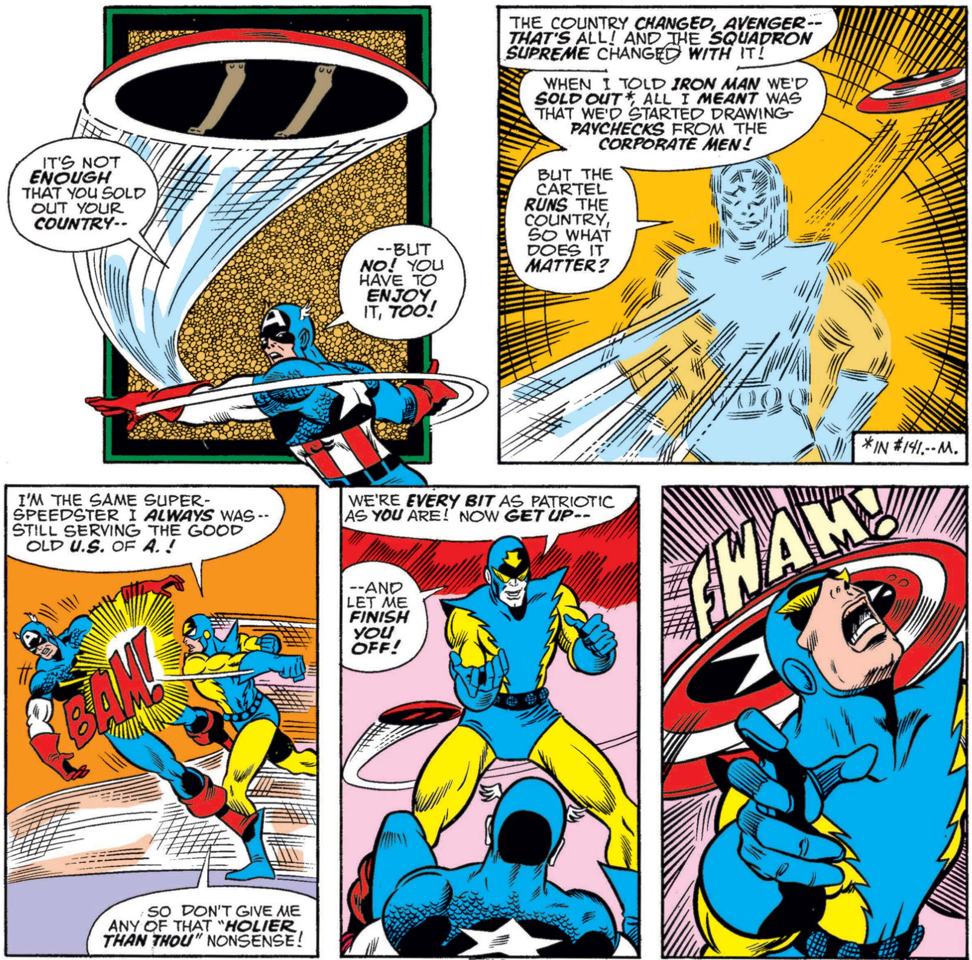
[Avengers #148]
Frankly, the Squadron Supreme element of The Serpent Crown Saga is its least interesting facet. But for clarity’s sake, the Squadron Sinister formed by Elder of the Universe the Grandmaster in 1969’s Avengers #69-71, wherein he even created a villainous version of Hyperion (later killed in the Squadron Supreme maxi by Mark Gruenwald, 1985-1986), but the Squadron Supreme that we see throughout this story was introduced a little later in #85; their alternate world has since been designated Earth-712. So, the Whizzer we see here already had a 616 counterpart, the speedster now known as Speed Demon (a Spidey villain nowadays). Skylark, however, has no analogue. But Hawkeye Clint Barton did briefly take on the identity of the Golden Archer, in Englehart’s Captain America #179 (1974)—apparently just so that the E-712 version could take on this title in The Serpent Crown Saga because he had first been known as E-712’s Hawkeye!
(Neither do American Eagle or Tom Thumb have E-616 analogues, though the American Eagle name is identified with the much better known but totally unrelated Jason Strongbow of Earth 616. If anything, Strongbow’s Native American identity makes the name more fitting for him, whereas the winged man of Earth-712 is clearly an unflattering take on DC’s crypto-fashy Carter Hall.)
With the Squadron Supreme removing the Serpent-possessed President Rockefeller from office, everything is now set up on Earth-712 for Mark Gruenwald’s forgotten classic Squadron Supreme maxi a decade later, which would touch on many of the themes of Watchmen a year before Alan Moore’s watershed moment.
NEXT TIME: The Ultron and Nefaria material from Avengers Epic Collection: The Final Threat, by Shooter, Pérez and Byrne.
The post When the Avengers Ruled, Part 1: The Serpent Crown Saga by Steve Englehart & George Pérez appeared first on Comic Book Herald.
